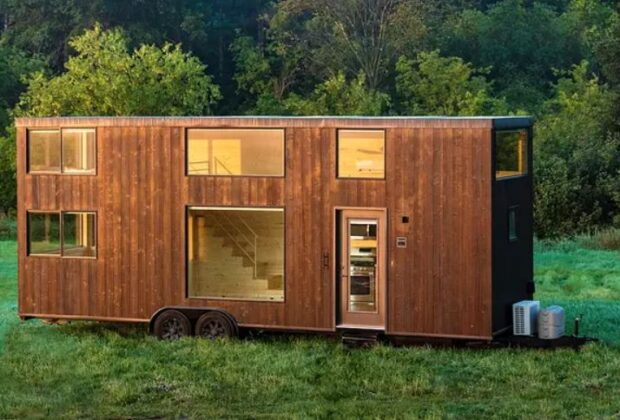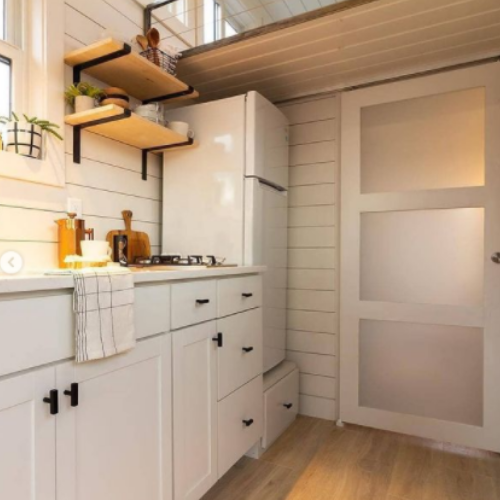Living in a tiny house is a minimalist and innovative lifestyle choice that comes with its unique challenges and opportunities. When designing a tiny house, several essential functions must be carefully considered to ensure a comfortable and functional living space.
Efficient Space Utilization
Efficient space utilization is a cornerstone of successful tiny house living, requiring a strategic approach to make the most out of limited square footage. In the realm of tiny houses, where space is at a premium, maximizing functionality is not just a design choice but a necessity for a comfortable lifestyle.
- Multi-functional Furniture: Incorporating furniture that serves multiple purposes is essential. Items like sofa beds, folding tables, and convertible furniture enable residents to transform their living space based on their current needs. This versatility ensures that each piece of furniture contributes to various aspects of daily life.
- Storage Solutions: Tiny houses thrive on clever storage solutions. From utilizing under-stair spaces to creating toe-kick drawers between cabinets, every nook and cranny is an opportunity for storage. Vertical storage, such as tall cabinets and wall-mounted shelves, helps keep belongings organized without sacrificing floor space.
- Built-in Features: Designing with built-in features is a hallmark of tiny house efficiency. Built-in seating with storage underneath, custom shelving units, and integrated appliances contribute to a seamless and purposeful design. These features are tailored to the dimensions of the space, ensuring a cohesive and functional layout.
- Optimizing Awkward Spaces: Tiny houses often have unique nooks and corners that might be challenging to furnish conventionally. Creativity comes into play when optimizing these awkward spaces, turning them into functional areas for storage or additional seating.
- Flexible Room Configurations: The ability to adapt and reconfigure rooms for different purposes is crucial. Sliding doors, curtains, or partition walls can create flexible living spaces that serve multiple functions, such as combining the living room and bedroom or converting a workspace into a dining area.
- Visual Continuity: Maintaining a visually continuous design creates an illusion of more space. A cohesive color palette, streamlined furniture, and open sightlines contribute to an uncluttered and expansive feel, despite the limited square footage.
Compact Kitchen Design: Thoughtful Efficiency for Tiny Spaces
In the heart of any home, the kitchen takes on a central role, and in the context of a tiny house, its design requires meticulous consideration. Crafting a compact kitchen that seamlessly combines functionality and space efficiency is a key element in making the most of limited square footage.
- Compact Appliances: Embracing specially designed compact appliances is paramount. Manufacturers now offer scaled-down versions of traditional kitchen essentials, including compact refrigerators, stovetops, and ovens. These smaller appliances not only save space but are tailored to meet the needs of a smaller household.
- Clever Storage Solutions: The success of a compact kitchen lies in its storage ingenuity. Employing vertical storage with wall-mounted shelves, utilizing under-cabinet spaces, and incorporating pull-out or pull-down storage units maximizes every inch. Multi-functional furniture with integrated storage compartments adds an extra layer of practicality.
- Functional Layout: A functional layout is the backbone of a compact kitchen. Adopting a galley or corridor kitchen design optimizes the use of limited space, ensuring that every area serves a purpose. Thoughtful placement of countertops, storage, and appliances creates an efficient workflow without sacrificing usability.
- Dual-Purpose Furniture: Integrate dual-purpose furniture elements into the kitchen design. Tables or countertops that can double as dining spaces or workstations enhance versatility. Folding or collapsible furniture allows for adaptability, ensuring the kitchen area remains open when not in use.
- Lighting and Visual Illusions: Strategic lighting choices and visual illusions play a crucial role in making a compact kitchen feel more expansive. Using light colors, ample natural light, and well-placed lighting fixtures contribute to an open and airy atmosphere.
- Customization for Specific Needs: Tiny house dwellers often have unique lifestyle needs. Customizing the kitchen design to cater to specific cooking habits, storage requirements, and appliance preferences ensures that the space is tailored to the individual or family living in the tiny house.
Creating a compact kitchen for a tiny house involves a delicate balance of form and function. By marrying thoughtful design with practical solutions, a fully equipped yet space-efficient kitchen becomes a reality, proving that even in the smallest spaces, culinary creativity can thrive. Find more ideas here: Kitchen space saving ideas
Smart Storage Solutions: A Clutter-Free Haven
Efficient storage solutions play a pivotal role in cultivating a clutter-free environment. Employing smart strategies ensures every inch of space is utilized effectively. Here are key smart storage solutions to keep your belongings organized:
- Under-Stair Storage: Transform the often-underutilized space beneath stairs into a functional storage haven. Custom-built drawers, shelves, or cabinets can be seamlessly integrated, providing a discreet yet accessible storage solution.
- Wall-Mounted Shelves: Maximize vertical space by installing wall-mounted shelves. These not only serve as practical storage for books, décor, or essentials but also add a touch of aesthetic appeal. Adjustable shelving systems offer versatility for different storage needs.
- Innovative Furniture with Built-In Storage: Opt for furniture designed with built-in storage capabilities. From beds with under-bed drawers to coffee tables with hidden compartments, innovative furniture ensures that every piece serves a dual purpose—both functional and storage-oriented.
- Modular and Stackable Storage: Embrace modular storage units that can be adapted to changing needs. Stackable storage bins, cubes, or baskets provide flexibility, allowing you to create a personalized and easily reconfigurable storage system.
- Over-Door Organizers: Capitalize on door space by using over-door organizers. Ideal for various items, these organizers can hold shoes, accessories, or cleaning supplies, making them easily accessible without occupying valuable floor or shelf space.
- Multi-Functional Furniture: Invest in multi-functional furniture that serves more than one purpose. Items like ottomans with hidden storage, nesting tables, or foldable furniture contribute to an organized living space without compromising on style.
- Customized Closet Systems: Tailor closets with customized storage solutions. Adjustable shelving, pull-out drawers, and specialized compartments ensure that every item has its designated place, making it easier to maintain order.
By strategically integrating these smart storage solutions, you can create a harmonious living space that not only promotes organization but also enhances the overall aesthetic appeal of your home.
Smart Home Technologies: A Greener Tomorrow
In the quest for sustainability, the integration of advanced technologies in smart homes contributes significantly to reducing environmental impact. Here's how smart thermostats and space-saving electronics enhance functionality while minimizing their ecological footprint:
- Smart Thermostats for Energy Efficiency: Smart thermostats, equipped with intelligent sensors and learning algorithms, optimize heating and cooling systems based on usage patterns. This results in reduced energy consumption, lower utility bills, and a smaller carbon footprint. Studies indicate that these devices can offer more environmentally friendly, energy-saving solutions, contributing to a greener lifestyle1.
- Energy-Efficient and Space-Saving Electronics: The design of space-saving electronics prioritizes efficiency and sustainability. Compact devices not only utilize fewer raw materials during manufacturing but also consume less energy during operation. This dual benefit enhances functionality while adhering to eco-friendly principles.
- Maximizing Space Utilization: Space-saving electronics are designed with a focus on efficient space utilization. Compact gadgets and appliances ensure that living spaces are optimized, reducing the need for excessive resources in both production and daily usage. This approach aligns with the principles of sustainable living.
- Integration of Green Computing: Green computing principles, encompassing energy reduction, waste reduction, and sustainable practices, are embedded in the development of smart home technologies. This holistic approach aims to minimize the environmental impact of technology, aligning with the broader goals of eco-conscious living2.
By incorporating these smart home technologies, homeowners can enjoy the benefits of enhanced functionality and comfort while actively participating in the global movement towards a more sustainable and eco-friendly future.
Also see Tiny House Hot Water
Well-Designed Bathrooms: Compact and Comfortable
Creating a well-designed bathroom in a compact space involves strategic choices in fixtures and storage solutions. Here are key elements to consider for an efficient and comfortable small bathroom:
- Space-Efficient Showers: Opt for space-saving shower designs that make the most of the available square footage. Consider corner showers, walk-in showers with sliding doors, or compact shower-bath combos. These options provide functionality without compromising on style or comfort.
- Composting Toilets for Sustainability: Embrace eco-friendly practices with a composting toilet. These innovative fixtures contribute to sustainable living by converting waste into compost, reducing water usage, and providing an alternative to traditional flushing systems.
- Innovative Sink Designs: Maximize counter space with innovative sink designs tailored for small bathrooms. Wall-mounted sinks, corner sinks, or compact vanity units with built-in storage help maintain a clutter-free environment while offering essential functionality.
- Smart Storage Solutions: Efficient storage is crucial in small bathrooms. Explore creative storage solutions such as floating shelves, recessed cabinets, or over-the-toilet shelving. Utilizing vertical space helps keep toiletries and essentials organized without compromising the overall design.
Incorporating these well-thought-out elements ensures that a compact bathroom remains functional, stylish, and comfortable, proving that size is no limitation to a well-designed space.
Adequate Natural Lighting: Illuminating Tiny Spaces
In a confined space, adequate natural lighting is transformative, fostering an open and airy ambiance. Here are key strategies to ensure ample natural light, enhancing the perceived spaciousness of tiny homes:
- Skylights for Overhead Brilliance: Integrate skylights strategically to introduce sunlight from above. Skylights not only maximize daylight but also create an upward visual expansion, making the space feel more open.
- Larger Windows for Panoramic Views: Opt for larger windows to invite more daylight and provide panoramic views of the surrounding environment. Well-placed windows blur the boundaries between indoors and outdoors, amplifying the sense of space.
- Glass Doors for Seamless Connection: Incorporate glass doors to connect the interior with the external surroundings. This seamless transition allows natural light to flood the space, creating a welcoming and expansive atmosphere.
- Reflective Surfaces to Amplify Light: Strategically use reflective surfaces such as mirrors and light-colored materials to bounce and distribute natural light effectively. This enhances the luminosity of the space, making it feel brighter and more spacious.
- Thoughtful Window Treatments: Choose sheer or translucent window treatments to allow maximum light penetration while maintaining privacy. Avoid heavy curtains or dark blinds that obstruct the flow of natural light.
By combining these elements, tiny homes can harness the power of natural light, transforming compact spaces into well-lit and inviting environments.
Off-Grid Living in Tiny Houses: Embracing Sustainability
Tiny houses epitomize off-grid living by integrating various eco-friendly solutions. To enhance off-grid capabilities, consider incorporating the following elements:
- Renewable Energy Sources: Tiny homes often leverage solar panels, wind turbines, or hydroelectric systems to generate electricity sustainably. Embrace these renewable energy sources to power your home and reduce reliance on conventional grids[6]. See : USING SOLAR PANELS AS YOUR ENERGY SOURCE
- Water Conservation Systems: Implement water-saving fixtures, rainwater harvesting, and greywater recycling systems to optimize water usage. These measures not only contribute to environmental conservation but also enhance the self-sufficiency of your tiny home[3].
- Composting Solutions: Composting toilets provide an eco-friendly alternative, converting human waste into nutrient-rich compost. This sustainable sanitation solution is well-suited for off-grid tiny homes, reducing the environmental impact and promoting self-sufficiency[2].
By integrating these off-grid capabilities, tiny houses can operate independently of traditional utilities, offering a sustainable and environmentally conscious lifestyle.
Minimalistic Aesthetics for Tiny Homes: Creating Visual Spaciousness
Adopting a minimalist design philosophy enhances the visual spaciousness of tiny homes. Follow these principles for a harmonious and visually appealing interior:
- Light Colors: Opt for a palette of light colors such as whites, grays, and beiges. Light tones create an open and airy atmosphere, making the limited space feel more expansive[1].
- Simple Décor: Embrace simplicity in decor by selecting clean lines and uncluttered furnishings. Minimalist decor reduces visual noise, contributing to a sense of tranquility and order in a small space[3].
- Cohesive Design Theme: Establish a cohesive design theme that runs throughout the tiny home. Consistency in design elements, such as furniture style and color scheme, fosters visual continuity and a unified aesthetic[2].
By integrating these minimalistic aesthetics, you can transform your tiny home into a serene and visually spacious haven.
Outdoor Living Space for Tiny Homes: Embracing Nature and Functionality
Enhance your tiny house living experience by extending the space outdoors with a carefully designed patio or deck. This addition not only amplifies the overall functionality of your tiny home but also creates a seamless connection to nature. Here's how outdoor living spaces can benefit your tiny home:
- Well-Designed Patio or Deck: Plan and create an outdoor space that complements your tiny home's design. A well-designed patio or deck can serve as an extension of your living area, providing a versatile space for relaxation and activities[1].
- Connection to Nature: Enjoy the beauty of the surrounding environment by integrating outdoor living spaces. Connecting to nature enhances the overall well-being of tiny house dwellers and creates a peaceful retreat right outside your door[6].
- Additional Room for Activities: Maximize the utility of your tiny house by utilizing outdoor areas for various activities. Whether it's outdoor dining, gardening, or simply enjoying the fresh air, the additional space contributes to a more versatile and dynamic living experience[3].
By incorporating outdoor living spaces, tiny homes can offer a harmonious blend of compact interiors and expansive natural surroundings.
The Art of Tiny House Living: Balancing Functionality, Innovation, and Comfort
Achieving success in the realm of tiny house living hinges on a delicate equilibrium among functionality, innovation, and comfort within the constraints of limited space. Here's a breakdown of the key elements contributing to the triumph of a tiny house:
- Functionality:
The essence of a well-designed tiny house lies in its functional prowess. Every square inch must serve a purpose, fostering efficiency and ensuring that the space caters to the basic needs of its inhabitants[3]. - Innovation:
Tiny houses are hotbeds for innovation. The creative use of space, incorporation of modular furniture, and ingenious storage solutions are hallmarks of tiny house design, often setting trends for broader applications[1][5]. - Comfort:
Despite its diminutive size, a tiny house should be a sanctuary of comfort. Thoughtful design choices, quality materials, and ergonomic considerations contribute to a cosy and inviting living space[2].
In conclusion, the triumph of a tiny house isn't just about squeezing into a small space; it's about elevating lifestyle. By judiciously prioritizing functionality, embracing innovation, and ensuring comfort, individuals can craft a tiny house that not only fulfils their basic needs but also enriches their daily lives.



